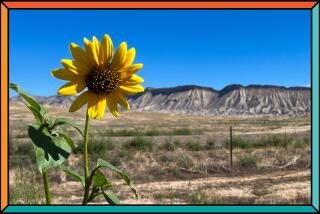Wonder From Down Under
You might not build a scene around it, but when you need an oddball character for a garden role, try a banksia. Among Australian plants at home in California, they are one of the strangest, with thistle-like flower cones and nutty-looking pods. These sometimes creepy features have given them a place in Australian folklore. In a children’s book by May Gibbs--first published in 1918 and still in print--tots are snatched from the bush by the big bad Banksia men.
But according to Australia-born Jo O’Connell, a Ventura grower known as the Banksia Lady, the plants have a mild and willing temperament. Named for Joseph Banks, the English botanist who first collected them while exploring Australia with Captain Cook in 1770, banksias range from ground covers (Banksia blechnifolia) to large trees (Banksia littoralis). They belong to the protea family of large, colorful flower clusters, which explains their otherworldly looks, and in their native Australian habitat they tend to grow along the sunny, scrubby coast where the soil is poor and dry. They have a double root system--one thick, long tap root that burrows deep in the search for water, and a shallow network of root clusters that extract nutrients from the soil. Thirty-six of the 75-plus banksia species have fire-tolerant trunks, and most have seed pods that pop open only with prolonged exposure to heat, another self-preserving adaptation to wildfire.
As garden plants, they have several particularly charming traits. Many feature two-tone leaves, with green on top and silver underneath, that shimmer in the breeze. About half of the species flower in the winter while other plants nap, and their blooms can be spectacular, emerging by the score over several weeks. These flowers are often honey-scented and nectar-rich, attracting hummingbirds and bees. Once done flowering, they become knobby pods that can be forced open by popping them into the oven for about an hour at 450 degrees. Remove the seeds, tuck them into cactus mix and, presto, another banksia.
These plants like lots of sun and well-drained soil. They’re acid-loving, so in Los Angeles’ alkaline soil they need occasional jolts of soil sulfur and iron chelate to keep their leaves from turning yellow. Go easy on the fertilizer, which can boost their growth but shorten their life. Feed once a year, if at all, in late winter with a low-phosphorus, slow-release product such as fish emulsion. Let the soil dry--but not dry out--between infrequent deep waterings. Be liberal with mulch, which cools the roots, reduces moisture loss and improves the soil structure. For the first year, spread organic compost around the plants every three months; during year two, renew it twice; after that, add it annually. As for pruning, O’Connell says you can trim young plants for shape, but if you’ve selected a banksia that’s right for your garden, you won’t need the clippers thereafter.
A large number of banksias are suited to Southern California. Blechnifolias thrive in sun or shade, and with their pink-flushed new growth are especially lovely in pots. Banksia integrifolia can become an easy-to-tend tree, and is happy from inland Santa Monica to Pasadena. Among other winners, Banksia baxteri has striking lime-green foliage, Banksia serrata has an interesting wrinkled trunk and Banksia grandis, which tolerates frost as well as heat or shade, has bloom stalks a foot long and 8 inches wide. Cut banksia flowers last for weeks indoors if you trim their stems and refresh their water. Or leave them out of water and they will dry and last just about forever.
Few nurseries in Southern California carry banksias, but O’Connell’s Australian Native Plants does sell them to Seaside Gardens in Carpinteria, Cedros Gardens in Solana Beach and Worldwide Exotics in Lakeview Terrace.
O’Connell loves the plants’ quirks as well as their familiarity. “I remember going out into the bush for picnics when I was a child,” she says. “Banksias were everywhere, as common as toyons in the chaparral.” Given their towering forms and odd features, it isn’t a stretch to imagine being waylaid by some. Which is what happened to O’Connell, who has spent 30 years growing them.
*
Resource Guide
Australian Native Plants, Ventura, (805) 649-3362, www.australianplants.com. Seaside Gardens, Carpinteria, (805) 684-6001. Cedros Gardens, Solana Beach, (858) 792-8640. Worldwide Exotics, Lakeview Terrace, (818) 890-1915.






